Brewster H.D. Mathematical Physics
Подождите немного. Документ загружается.

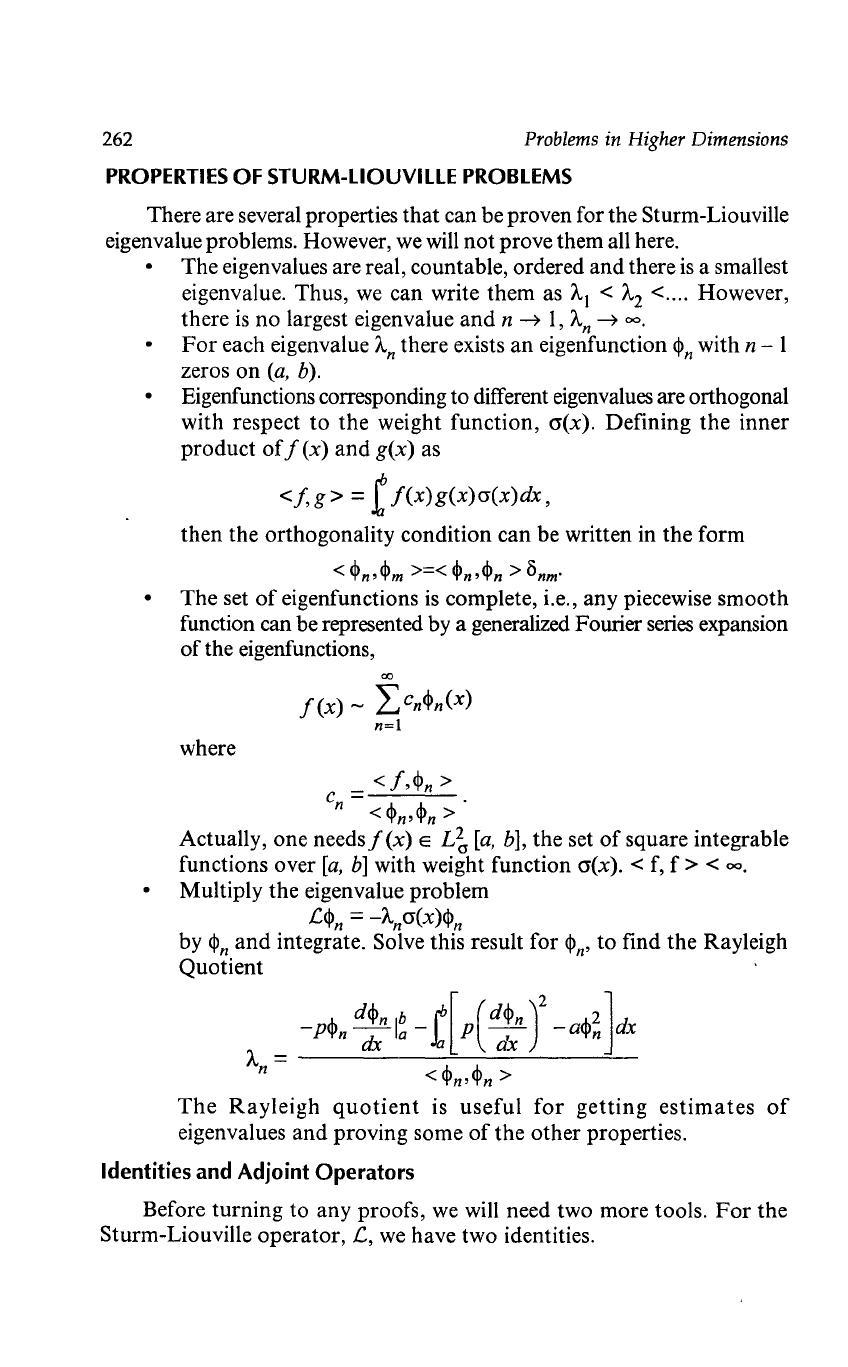
262
Problems
in
Higher
Dimensions
PROPERTIES
OF STURM-LIOUVILLE
PROBLEMS
There are several properties
that
can be proven for the Sturm-Liouville
eigenvalue problems. However, we will
not
prove them all here.
• The eigenvalues are real, countable, ordered
and
there
is
a smallest
eigenvalue. Thus, we can write them as
A)
<
A2
<
....
However,
there
is
no
largest eigenvalue
and
n
~
I,
An
~
00.
For
each eigenvalue
An
there exists
an
eigenfunction
<Pn
with n - I
zeros
on
(a,
b).
• Eigenfunctions corresponding to different eigenvalues are orthogonal
with respect
to
the
weight function, cr(x). Defining
the
inner
product
off
(x)
and
g(x) as
<j,
g > = r
f(x)
g(x)
cr(x) dx ,
then the orthogonality condition can be written in
the
form
<
<Pn'~m
>=<
~n'~n
>
l>nm·
• The set
of
eigenfunctions
is
complete, i.e., any piecewise
smooth
function can be represented by a generalized Fourier
series
expansion
of
the eigenfunctions,
00
f(x)
-
2>n~n(x)
n=l
where
<f'~n
>
c =
---''---'-'-=---
n
<~n'~n
>
Actually, one
needsf(x)
E
L~
[a,
b],
the set
of
square integrable
functions over
[a,
b]
with weight function
cr(x).
< f,
f>
<
00.
• Multiply the eigenvalue problem
.c<Pn
=
-Ancr(x)<P
n
by
<Pn
and
integrate. Solve this result for
<P
n
,
to
find the Rayleigh
Quotient
A =
-~n~l~
-
t[p(
~
r
-,*~
}Ix
n
<~n'~n
>
The
Rayleigh
quotient
is
useful
for
getting
estimates
of
eigenvalues
and
proving some
of
the other properties.
Identities
and
Adjoint
Operators
Before turning to any proofs, we will need two more tools.
For
the
Sturm-Liouville operator,
.c,
we have two identities.
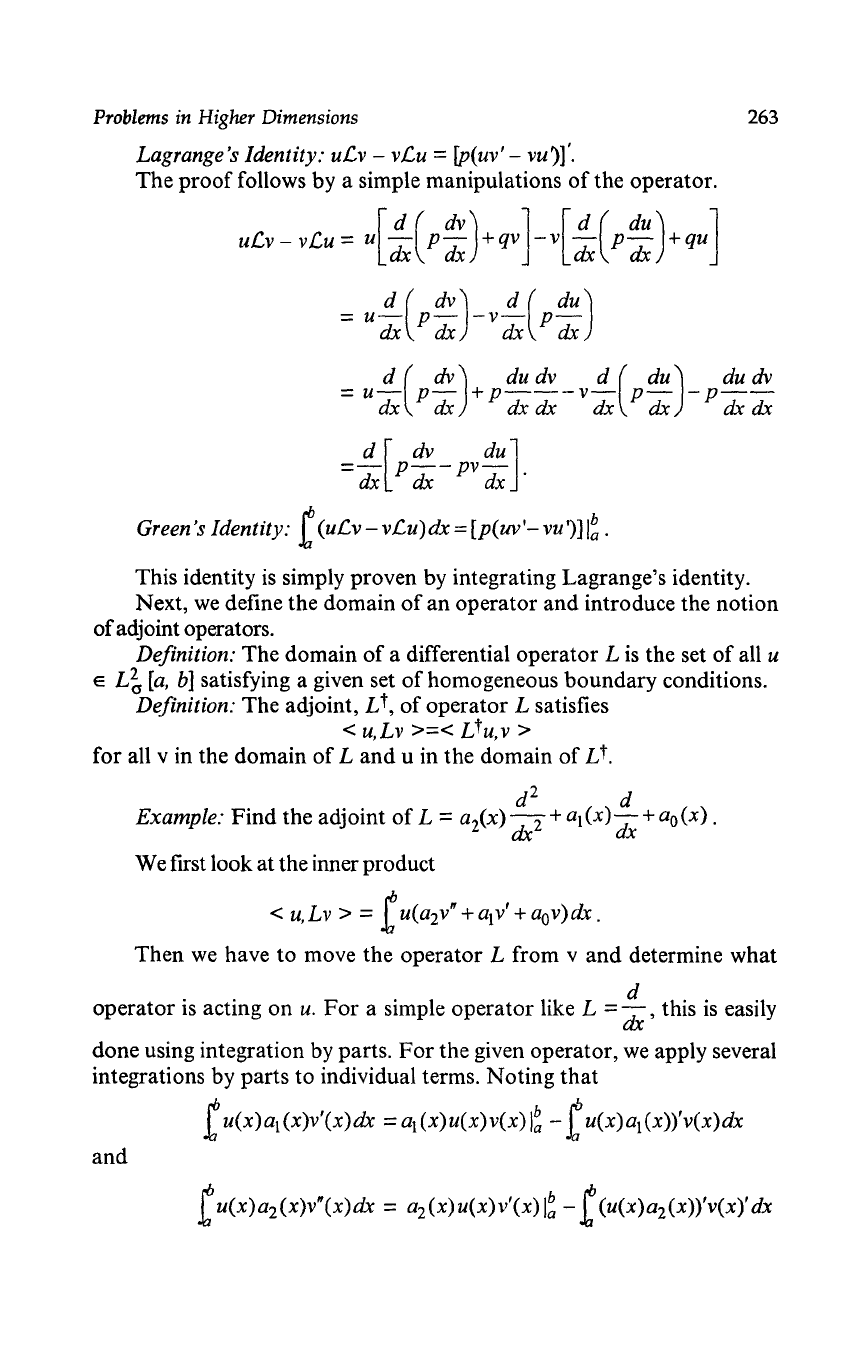
Problems
in
Higher
Dimensions
263
Lagrange's
Identity:
ULV
-
VLU
= [P(uv' - vu))'.
The
proof
follows by a simple manipulations
of
the operator.
= U
!(P:)-V
!(P:)
=
u~(p
dv)+
P
du
dv
-v~(p
dU)_
P du
dv
dx dx
dx
dx
dx
dx dx dx
=
![P:
-
pv~:].
Green's
Identity:
r
(ULV-l'LU)dx=[p(uv'-l'u')]I~.
This identity
is
simply proven by integrating Lagrange's identity.
Next,
we
define
the
domain
of
an
operator
and
introduce the notion
of
adjoint operators.
Definition:
The
domain
of
a differential operator L
is
the set
of
all U
E
L~
(a,
b]
satisfying a given set
of
homogeneous
boundary
conditions.
Definition:
The
adjoint, L t,
of
operator L satisfies
<
u,Lv
>=<
Ltu,v
>
for all v in the domain
of
Land
u in the domain
of
Lt.
d
2
d
Example:
Find
the adjoint
of
L = a
2
(x)
dx
2
+ a\
(x)
dx +
ao(x).
We first look at the inner product
<
u,Lv
> = r u(a2
v
" +
a\l"
+ aol')dx.
Then
we
have to move
the
operator L from v
and
determine
what
d
operator is acting
on
u.
For
a simple
operator
like L =
dx'
this
is
easily
done using integration by parts.
For
the given operator,
we
apply several
integrations by parts to individual terms.
Noting
that
r
u(x)a\
(x)l"(x)dx
=
a\
(x)u(x)v(x)
I~
-r
u(x)a\
(x»,l'(x)dx
and
r
u(x)a2(x)l'"(x)dx
=
a2(x)u(x)v'(x)
I~
-r
(u(x)a2(x»'l'(x)'
dx
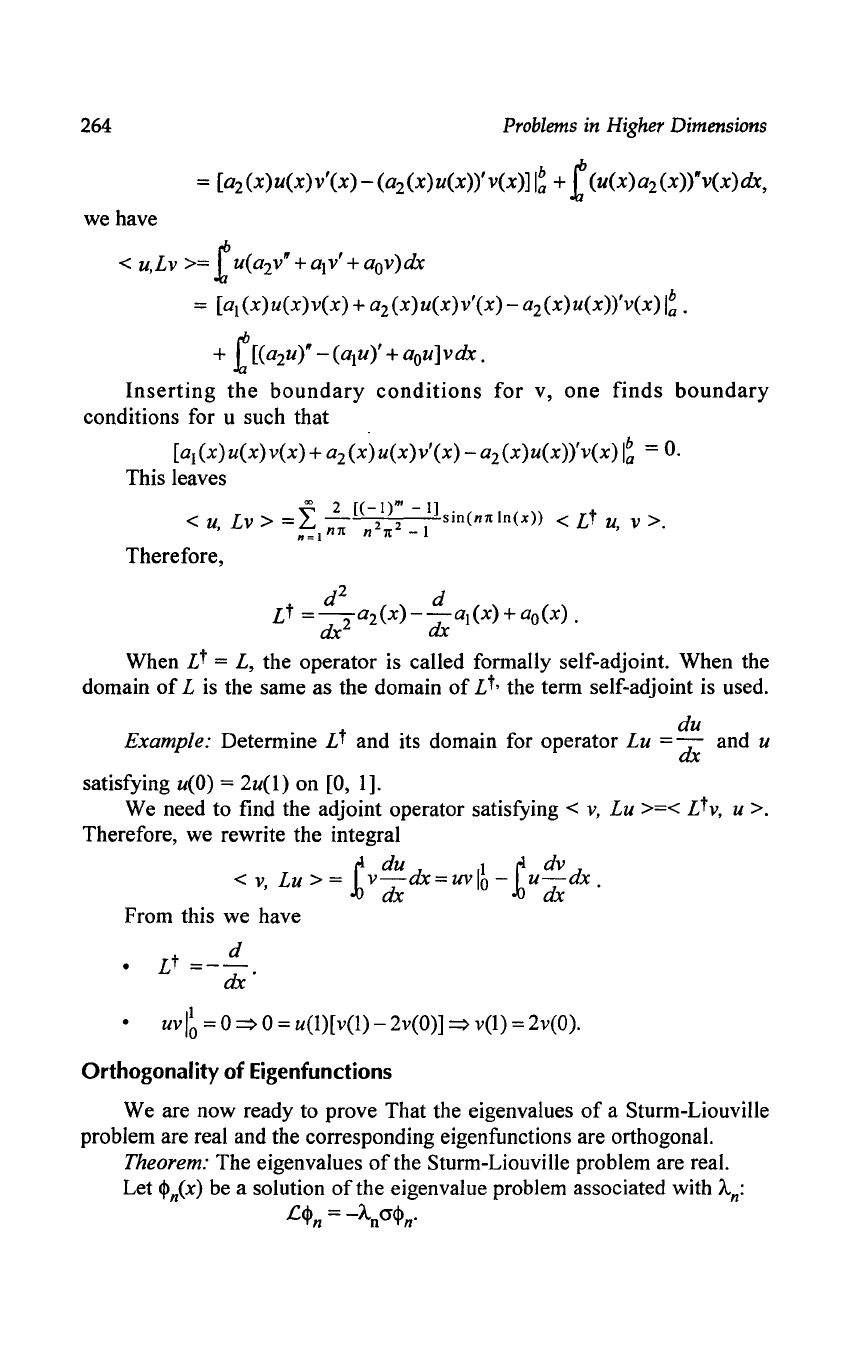
264
Problems
in
Higher Dimensions
= [a2(X)U(X)V'(X)
-(a2(x)u(X»'V(X)]
I~
+ 1
(u(x)a2(x)lv(x)dx,
we
have
< u,Lv >= 1
u(a2
v
"
+al
v
' +aov)dx
= [al
(x)u(x)v(x)
+
a2
(x)u(x)v'(x)
- a2(X)u(X»'V(X)
I~
.
+
1[(a2Ul-(alU)'
+aou]vdx.
Inserting
the
boundary
conditions
for v,
one
finds
boundary
conditions for u such that
[al
(x)u(x)v(x)
+
a2
(x)u(x)v'(x)
-
a2(x)u(x»'v(x)
I~
=
o.
This leaves
'"
2
[(_I)m
-I]
.
<
u,
Lv
> = I 2 2
sJn(nlt
In(x»
<
Lt
u,
v
>.
n=lnlt
n
It
-I
Therefore,
d
2
d
Lt
= dx
2
a2(x)-
dx
al(x)
+ ao(x) .
When
Lt
=
L,
the operator is called formally self-adjoint. When the
domain
of
L
is
the same as the domain
of
Lt,
the term self-adjoint
is
used.
du
Example:
Determine
Lt
and its domain for operator
Lu
= dx and u
satisfying
u(O)
= 2u(1) on [0,
1].
We
need to find the adjoint operator satisfying <
v,
Lu
>=< Ltv, u
>.
Therefore, we rewrite the integral
<
v,
Lu
> = £
v~:
dx=uvl~
-
£u:
dx.
From this we have
•
•
d
Lt
=-
dx .
uvl~
= 0
~
0 = u(1)[v(l) - 2v(0)]
~
v(1)
=
2v(O)
.
Orthogonality of Eigenfunctions
We are now ready to prove That the eigenvalues
of
a Sturm-Liouville
problem are real and the corresponding eigenfunctions are orthogonal.
Theorem: The eigenvalues
of
the Sturm-Liouville problem are real.
Let
<Pn(x)
be a solution
of
the eigenvalue problem associated with
An:
£<Pn
=
-AnO"<Pn·
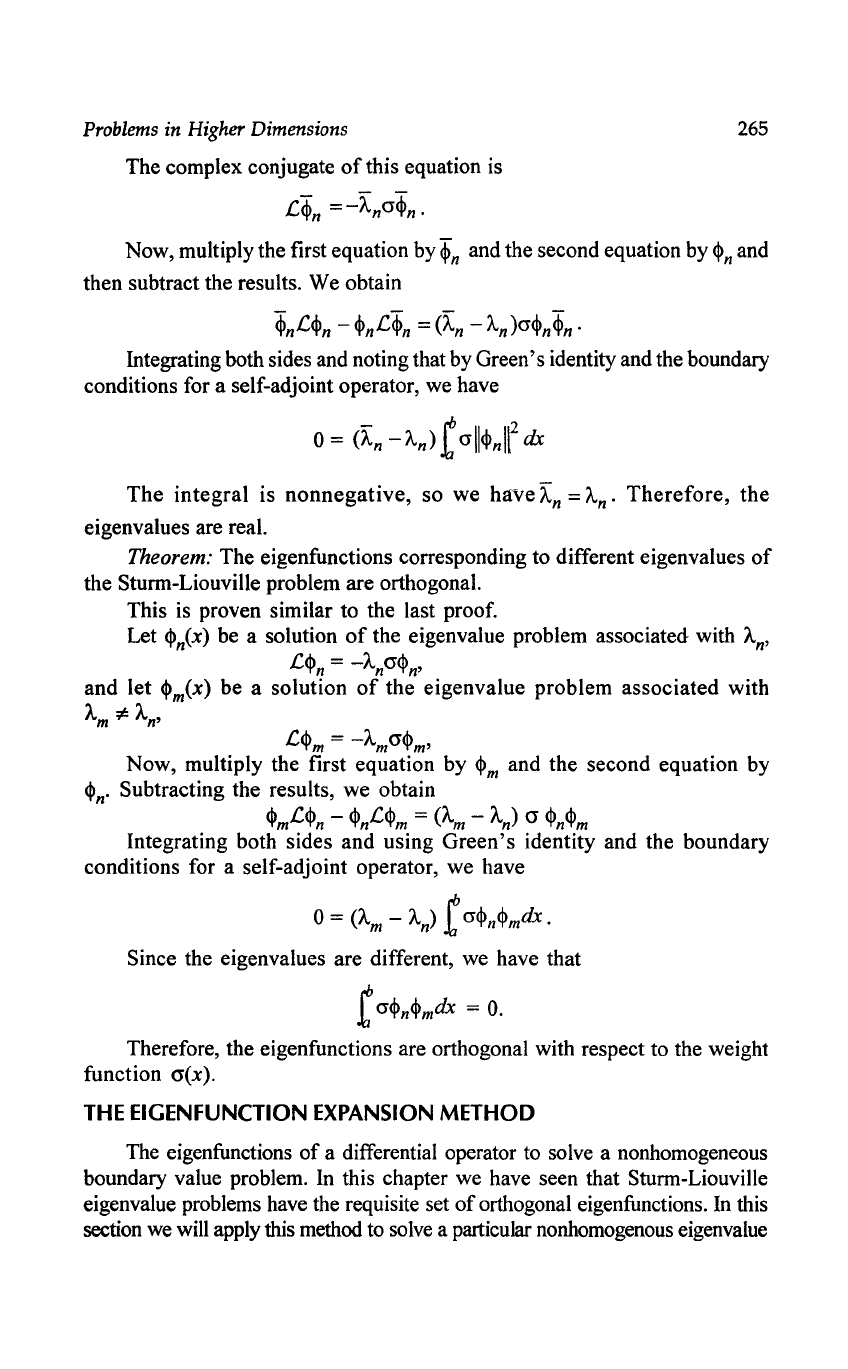
Problems
in
Higher
Dimensions
265
The complex conjugate
of
this equation is
.c~n
=
-~ncr~n
.
Now, multiply the first equation by
~n
and the second equation by
<Pn
and
then subtract the results. We obtain
~n.c~n
-
~n.c~n
=
(~n
-
An
)cr~n~n
.
Integrating both sides and noting that by Green's identity and the boundary
conditions for a self-adjoint operator, we have
The
integral
is
nonnegative,
so we
have
~n
= An'
Therefore,
the
eigenvalues are real.
Theorem: The eigenfunctions corresponding to different eigenvalues
of
the Sturm-Liouville problem are orthogonal.
This is proven similar to the last proof.
Let
<Pix)
be a solution
of
the eigenvalue problem associated with
An'
.c<Pn
=
-AnO'<Pn'
and
let
<pm(x)
be a solution
of
the eigenvalue problem associated with
Am;¢:'
An'
.c<Pm
=
-AmO'<Pm'
Now, multiply the first equation by
<Pm
and the second equation by
<Pn'
Subtracting the results, we obtain
<Pm.c<Pn
-
<Pn.c<Pm
=
(Am
-
An)
0'
<Pn<Pm
Integrating both sides and using
Green's
identity and the boundary
conditions for a self-adjoint operator, we have
0=
(Am
-
An)
r
cr~n~md.x.
Since the eigenvalues are different, we have that
r
cr~n~md.x
=
O.
Therefore, the eigenfunctions are orthogonal with respect to the weight
function
O'(x).
THE EIGENFUNCTION EXPANSION
METHOD
The eigenfunctions
of
a differential operator to solve a nonhomogeneous
boundary value problem.
In
this chapter we have seen that Sturm-Liouville
eigenvalue problems have the requisite set
of
orthogonal eigenfunctions.
In
this
section
we
will apply this method to solve a particular nonhomogenous eigenvalue

266
Problems
in
Higher Dimensions
problem. Recall that one starts with a nonhomogeneous differential equation
Ly=f
where
y(x)
is to
satisfy
given homogeneous
boundary
conditions. The
method makes use
of
the eigenfunctions satisfying the eigenvalue problem
L<Pn
=
-Ana<Pn
subject to the given boundary conditions. Then one assumes that
y(x)
can
be written as an expansion in the eigenfunctions,
00
y(x) =
2>n~n(x)
,
n=l
and inserts the expansion into the nonhomogeneous equation. This gives
f (x)
~
c(
~
c,$,(x)
J
~
-
~
C,A,cr(X
)$,(x)
The expansion coefficients are then found
by
making use
of
the
orthogonality
of
the eigenfunctions. Thus,
r
f(x)~m(x)dx
em
=
Am
r
~~(x)cr(x)dx
.
As an
example,
we
consider
the
solution
of
the
boundary
value
problem
(
')'
y I
xy
+-=-,
X E
[I,e],
x x
y(1)
= 0 = y(e).
This equation is already in self-adjoint form. So, we know that the
associated Sturm-Liouville eigenvalue problem has an orthogonal set
of
eigenfunctions. We first determine this set. Namely, we need to solve
(x~')'
+ 1 =
-Acr~,
~(l)
= 0 =
~(e)
x
Rearranging the terms and multiplying by x,
we
have that
X2~"
+
x~'
+
(1
+
AcrX)~
= 0 .
This is almost an equation
of
Cauchy-Euler type. Picking the weight
function
a(x)
=..!..,
we have
x
X2~"
+
x~'
+
(1
+
A)~
=
O·
This
is
easily solved. The characteristic equation
is
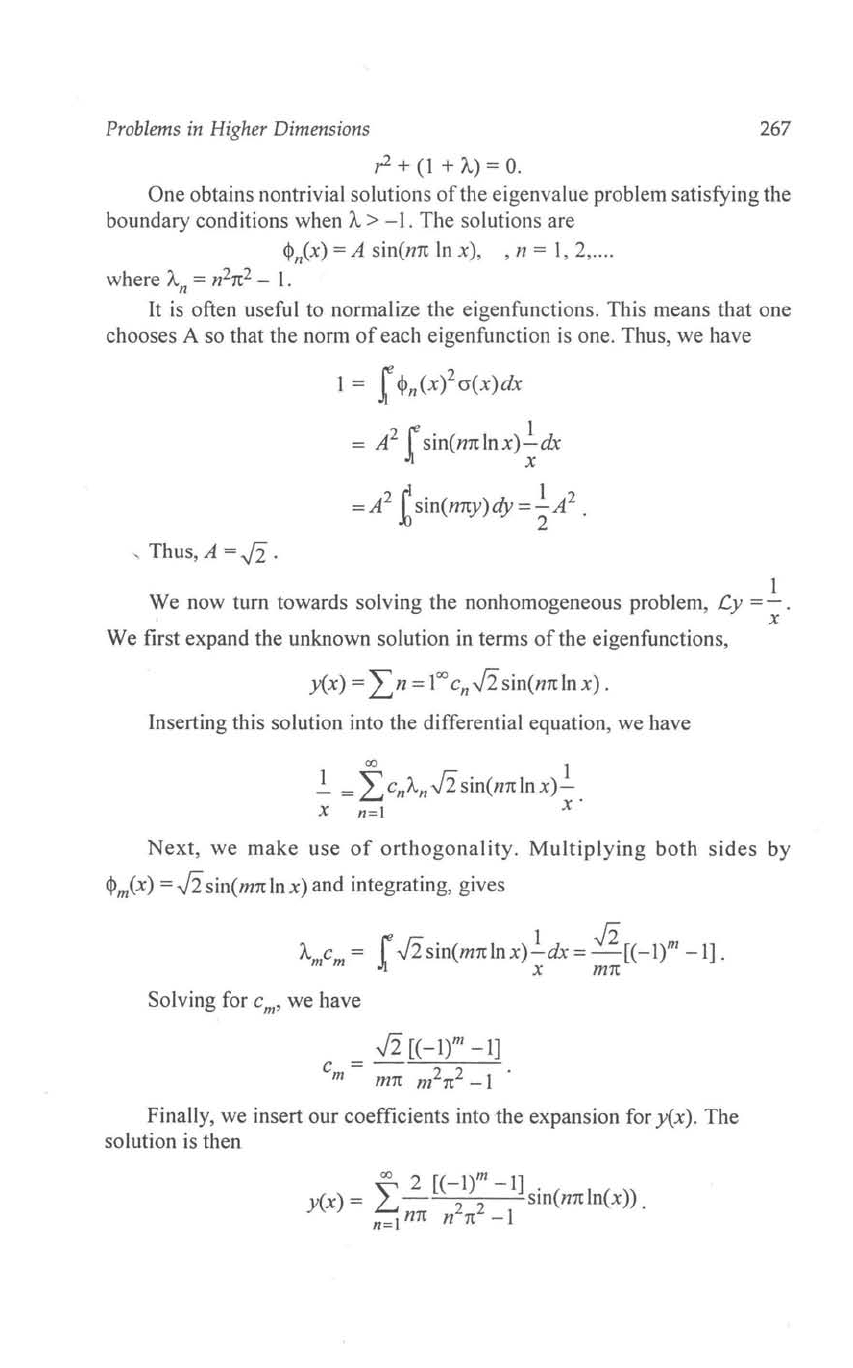
Problems in Higher Dimensions
267
,2 +
(l
+
A)
=
O.
One
obtains nontrivial solutions
of
the eigenvalue problem satisfying the
boundary conditions when
A>
-1.
The
solutions are
<pn(x)
= A sin(n1t
In
x), , n = I, 2, ....
where
An
= n
2
1t
2
-
I.
It is often useful to normalize the eigenfunctions. This means
that
one
chooses
A so that the norm
of
each eigenfunction is one. Thus,
we
have
" Thus, A
=.J2
.
1 = r
~n(x)2(J(x)dx
=
A2
r
Sin(n1tlnx)~dx
=A21sin(n1ty)dy=-iA2.
1
We
now turn towards solving the nonhomogeneous problem, ,Cy
=-.
. x
We
first expand the unknown solution in terms
of
the eigenfunctions,
y(x) =
L>
=
Ie<)
c
n
.J2
sin(mt
In
x) .
Inserting this solution into the differential equation, we have
Next,
we
make
use
of
orthogonality
.
Multiplying
both
sides
by
<pm(x)
=.J2
sin(m1t
In
x)
and integrating, gives
Solving for
cm'
we
have
.J2
[(_I)m
-1]
C
=-
m
m1t
m
2
1t
2
-1
.
Finally, we insert
our
coefficients into
the
expansion for y(x).
The
solution is then
e<)
2 [(_l)m
-1]
y(x) = I 2 2
sin(n1tln(x».
n=l
n1t
n
1t
-1
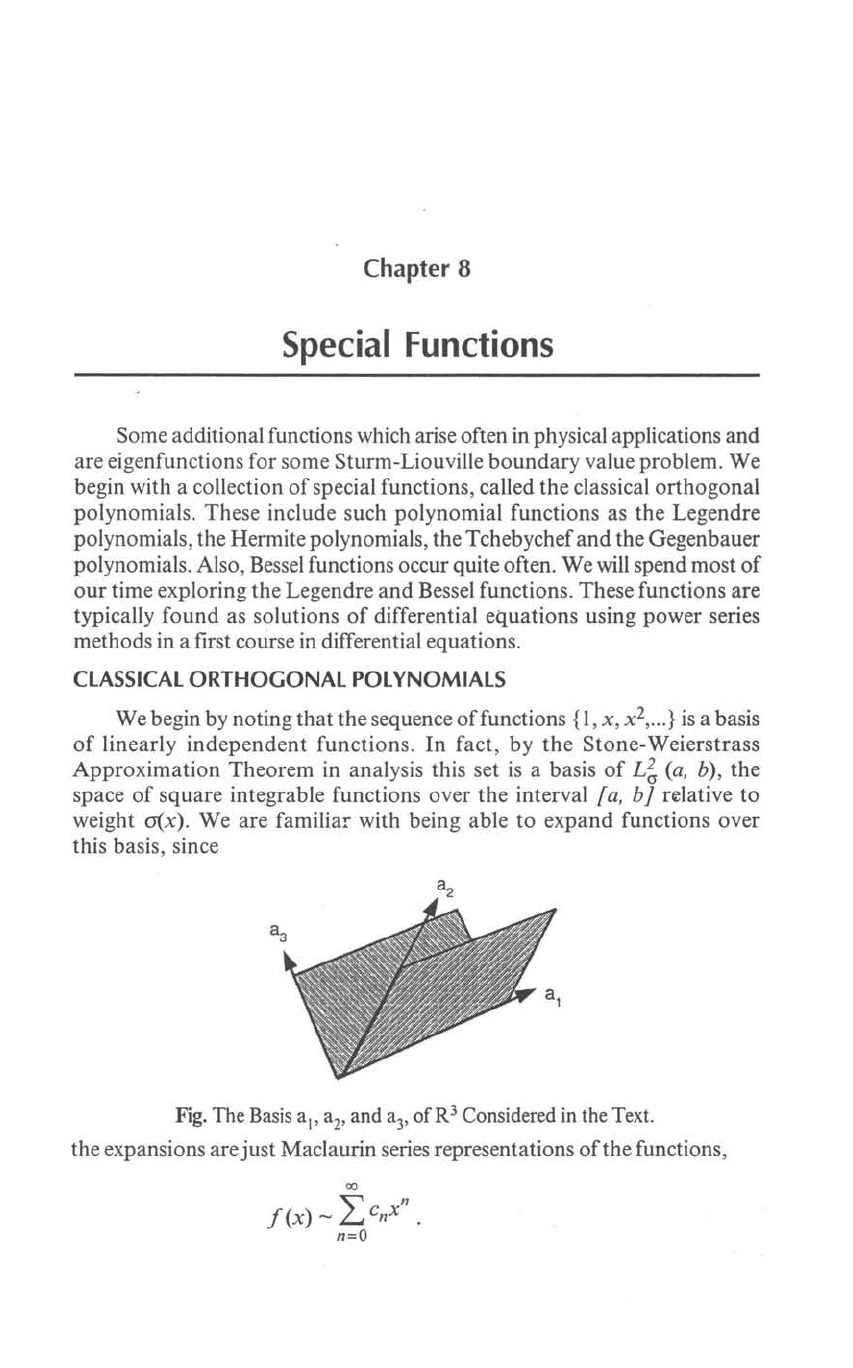
Chapter 8
Special
Functions
Some additional functions which arise often
in
physical applications and
are eigenfunctions for some Sturm-Liouville
boundary
value problem. We
begin with a collection
of
special functions, called the classical orthogonal
polynomials. These include such polynomial functions as the Legendre
polynomials, the Hermite polynomials, the Tchebychef
and
the Gegenbauer
polynomials. Also, Bessel functions occur quite often. We
will
spend most
of
our
time exploring the Legendre
and
Bessel functions. These functions are
typically
found as solutions
of
differential equations using power series
methods in a first course
in
differential equations.
CLASSICAL
ORTHOGONAL
POLYNOMIALS
We begin by noting that the sequence
of
functions {I,
x,
x
2
,
.•. }
is
a basis
of
linearly
independent
functions.
In
fact, by
the
Stone-Weierstrass
Approximation Theorem in analysis this set
is
a basis
of
L;
(a,
b), the
space
of
square integrable functions over
the
interval [a, b J relative to
weight
a(x)
. We are familiar with being able
to
expand functions over
this basis, since
Fig. The Basis at, a
2
,
and a
3
,
of
R
3
Considered in the Text.
the expansions are just Maclaurin series representations
of
the functions,
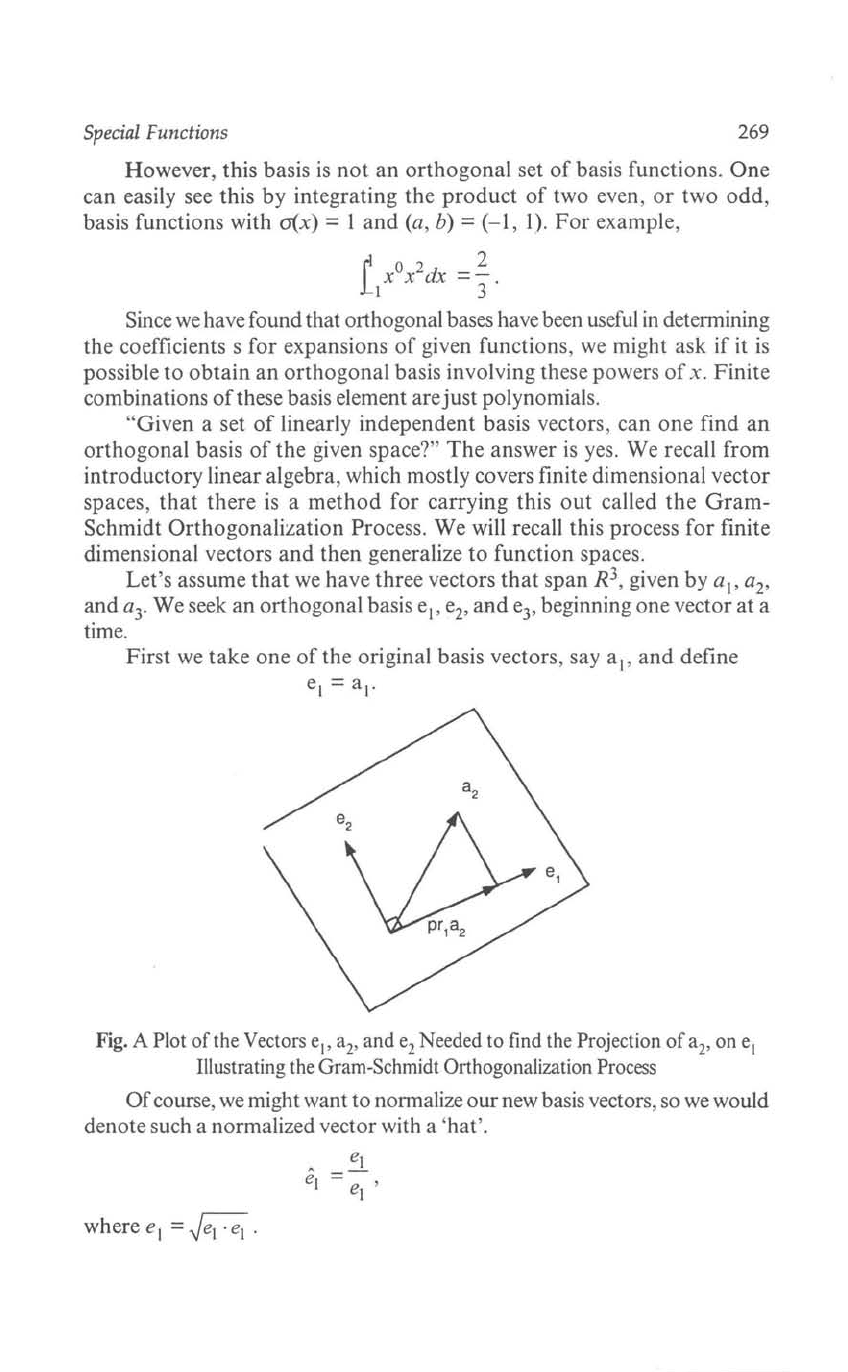
Special
Functions
269
However, this basis
is
not
an
orthogonal
set
of
basis functions.
One
can easily see this by integrating the
product
of
two even,
or
two
odd,
basis functions with
a(x)
= 1
and
(a, b) =
(-I,
I).
For
example,
r x
O
x
2
dx
=~
11
3·
Since
we
have found that orthogonal bases have been useful
in
detennining
the coefficients s for expansions
of
given functions,
we
might ask if it
is
possible
to
obtain an
orthogonal basis involving these powers
of
x.
Finite
combinations
of
these basis element are
just
polynomials.
"Given a set
of
linearly independent basis vectors, can
one
find
an
orthogonal basis
of
the
given space?"
The
answer
is
yes. We recall from
introductory linear algebra, which mostly covers finite dimensional vector
spaces,
that
there
is
a
method
for carrying this
out
called
the
Gram-
Schmidt Orthogonalization Process. We will recall this process
for
finite
dimensional vectors
and
then generalize
to
function spaces.
Let's assume
that
we
have three vectors
that
span R3, given by
at,
a
2
,
and
Q3.
We seek
an
orthogonal basis e
t
, e
2
,
and
e
3
,
beginning one vector at a
time.
First
we
take
one
of
the original basis vectors, say
at,
and
define
e
t
= at·
Fig. A Plot
of
the Vectors
e"
a
2
,
and
e
2
Needed
to
find the Projection
of
a
2
,
on e,
Illustrating the Gram-Schmidt Orthogonalization Process
Of
course,
we
might want to nonnalize our new basis vectors, so
we
would
denote such a normalized vector with a 'hat'.
wheree
l
=~.
~
el
= e '
1
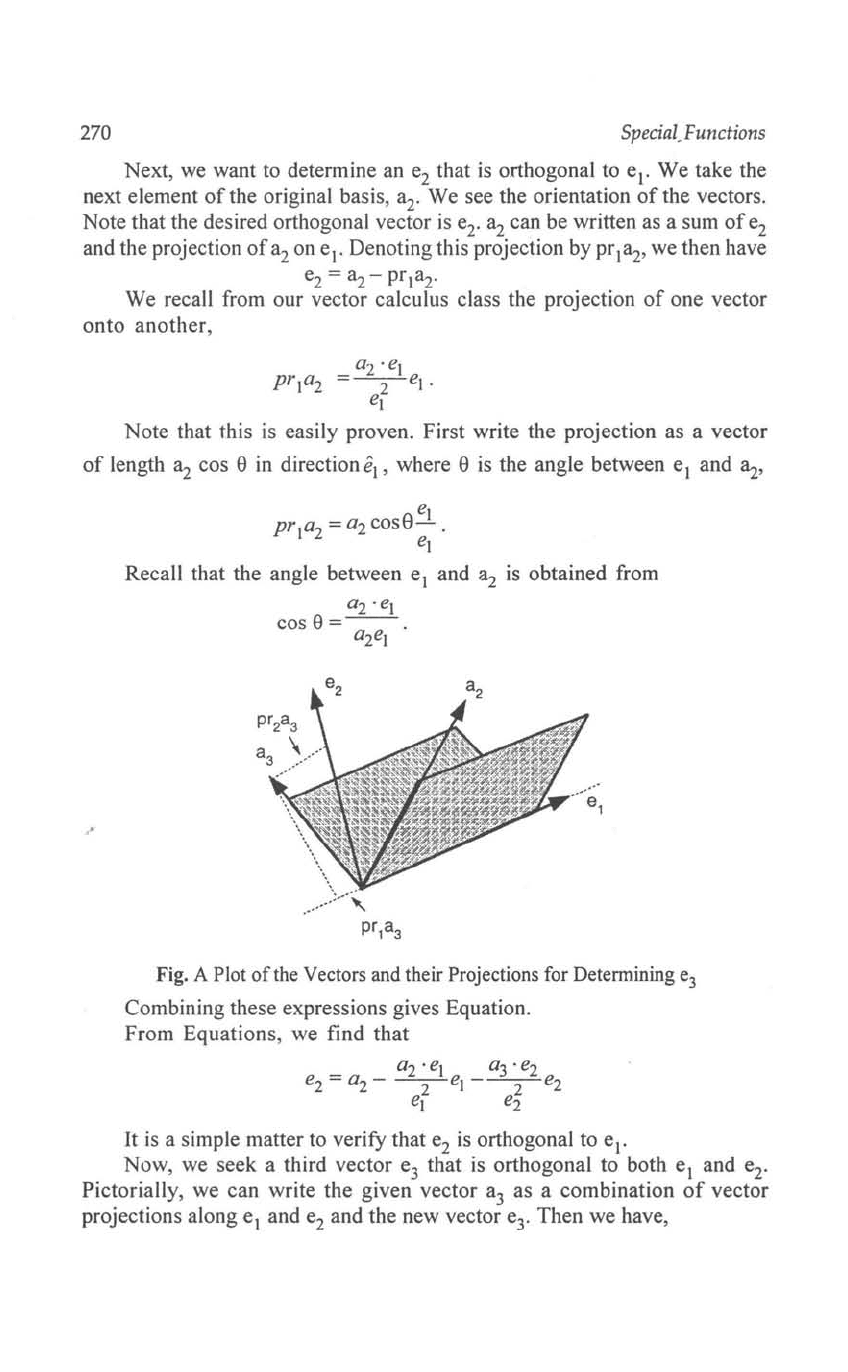
270 SpecialJunctions
Next, we want to determine an e
2
that
is
orthogonal to e
1
,
We take the
next element
of
the original basis, a
2
,
We see the orientation
of
the vectors,
Note that the desired orthogonal vector
is
e
2
,
~
can be written as a sum
of
e
2
and the projection
of
a
2
on e
1
,
Denoting this projection by pr
l~'
we then have
e
2
=
~-
pr\~,
We
recall from our vector calculus class the projection
of
one vector
onto another,
a2,e\
pr
1
a
2
=--2-
e
\,
e\
Note that this
is
easily proven, First write the projection as a vector
of
length
~
cos 8
in
direction
el
, where 8
is
the angle between e
1
and
~,
"
el
pr\a
2
= a2
cos8-,
el
Recall that the angle between e
1
and a
2
is
obtained from
a2,e\
cos
8=--
a2
e
\
Fig. A Plot
of
the Vectors and their Projections for Determining e
3
Combining these expressions gives Equation,
From Equations, we find that
a2,e\
a3
'e2
e
2
= a
2
-
--el
---e2
ef ei
It
is
a simple matter to verify that e
2
is
orthogonal to e
1
,
Now, we seek a third vector e
3
that
is
orthogonal to both e
1
and e
2
,
Pictorially, we can write the given vector a
3
as a combination
of
vector
projections along e
1
and e
2
and the new vector e
3
,
Then we have,
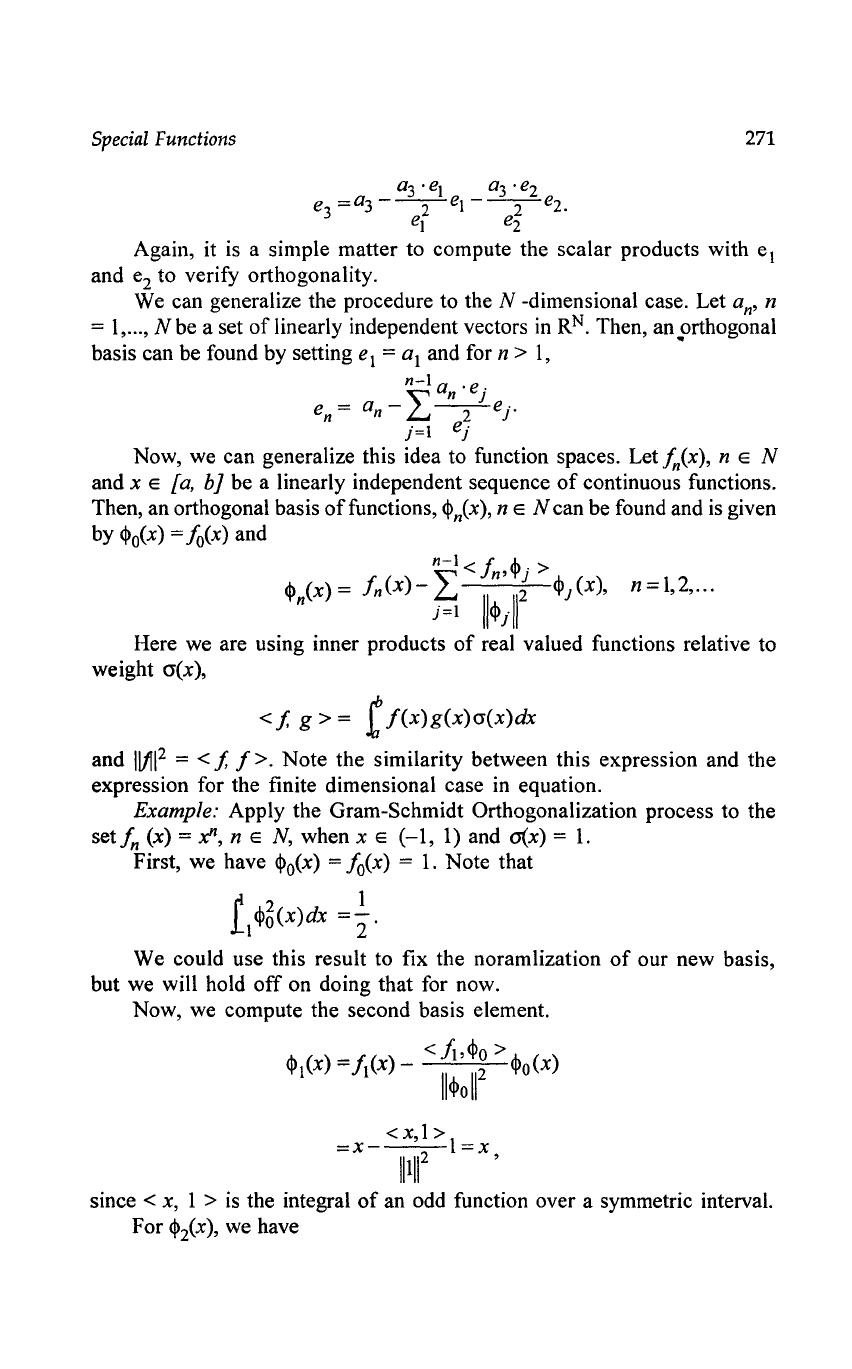
Special
Functions
271
a3
·el
a3
·e2
e
=a3
---el
---e2.
3
ef ei
Again, it is a simple
matter
to
compute the
scalar
products with e
l
and e
2
to
verify orthogonality.
We can generalize the procedure to the
N -dimensional case. Let
an'
n
= 1,,,., N be a set
of
linearly independent vectors
in
RN.
Then, an
..
orthogonal
basis can be found by setting
e
l
= a
l
and for n >
1,
n-l
a
·e·
e
n
= a
n
-
L~ej'
j=l
ej
Now, we
can
generalize this idea to function spaces. Let 1n(x), n E N
and
x E
[a,
hJ
be a linearly independent sequence
of
continuous functions.
Then,
an
orthogonal basis
off
unctions,
<l>n(x),
n E N can be found and is given
by
<l>o(x)
= fo(x) and
n-l
I'
'"
,,,<In''¥j>
<l>nC
x
)
=
fn(x)-
~
II<I>JJ
<I>/x),
n=I,2,
...
Here we are using inner products
of
real valued functions relative to
weight
a(x),
< f, g > = r
f(x)
g(x)
a(x)dx
and
111112
= < f, f >.
Note
the similarity
between this
expression and the
expression for the finite dimensional case in equation.
Example: Apply the Gram-Schmidt Orthogonalization process
to
the
setfn
(x) =
xn,
n E
N,
when x E
(-1,
1)
and a(x) =
1.
First, we have
<l>o(x)
= fo(x) =
1.
Note
that
r 2 1
il<l>o(x)dx
='2'
We
could use this result to fix
the
noramlization
of
our
new
basis,
but we will hold
off
on doing that for now.
Now, we compute the second basis element.
<
./i,<I>o
>
<l>l(x)
= flex) -
\\<1>0\\2
<1>0
(x)
= x - < x,
1
> 1 = x
I\lf
'
since < x, 1 > is the integral
of
an odd function over a symmetric interval.
For
<l>2(x),
we have
